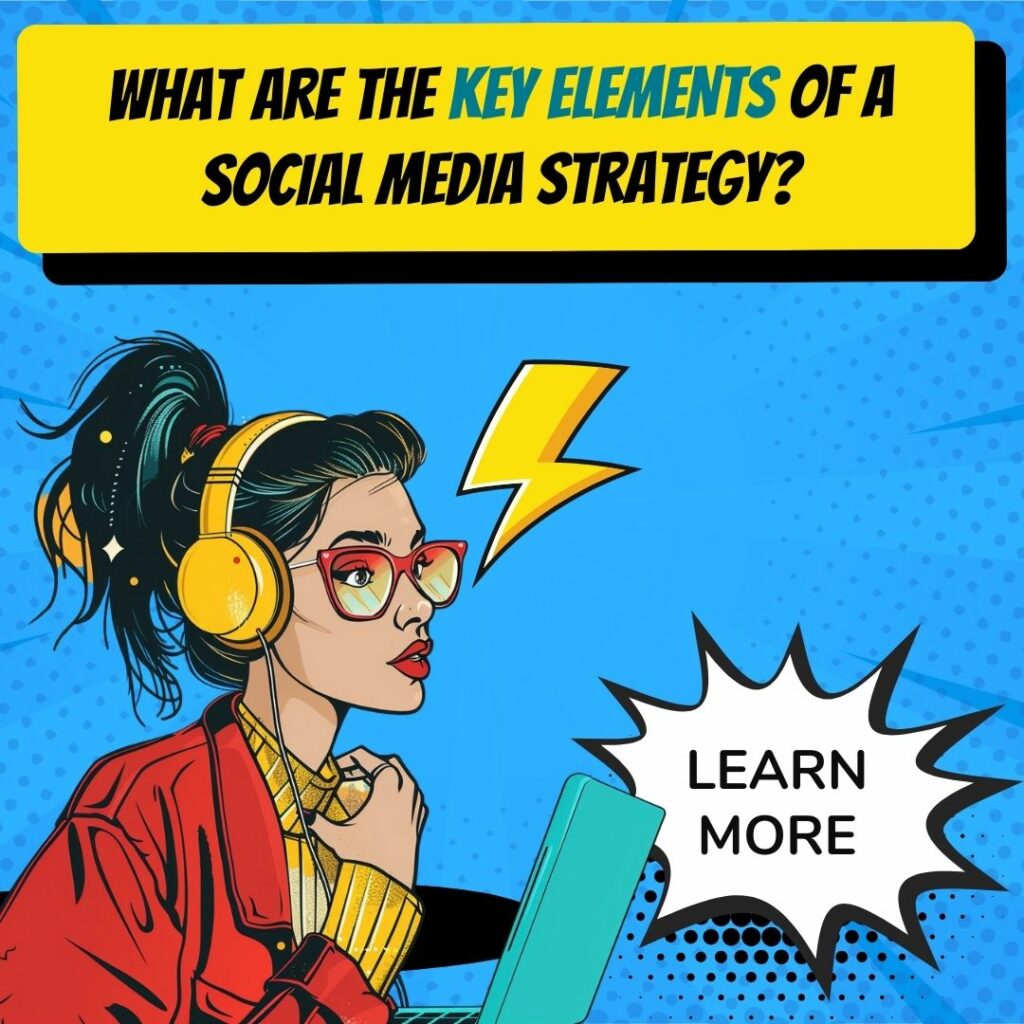Key Takeaways
✅ Know Your Audience: Unlock the potential of your brand with insights into your audience’s world. Delve into their preferences and pain points for a social strategy that speaks volumes.
✅ Brand Consistency: Forge a memorable digital identity with a cohesive brand image. Consistent messaging across social channels solidifies your position in the marketplace.
✅ Measure Success: Navigate the realm of social media with precision by tracking key metrics. Adjust your sails based on data-driven insights for a journey of continuous improvement.

Introduction
Are you fully harnessing the transformative power of social media to grow your business? In today’s hyper-connected world, a robust social media strategy is not just nice-to-have but a pivotal component of your marketing arsenal. A fine-tuned strategy can daybreak your brand into the consciousness of your ideal customer, creating waves of loyalty and dialogue that ripple through your industry.
Setting course through this digital landscape, you’ll encounter game-changing approaches, avant-garde trends, and an alphabet soup of acronyms—ROAS, ROI, and beyond—each promising to scale your brand’s foothills to mountainous peaks of revenue. This journey beyond visibility and engagement, into the heart of revenue generation and investment returns, is packed with actionable insights, waiting to be unlocked.
Tempted? Take this first step and discover the principles that will sculpt your social media presence into a powerhouse of genuine connection and conversion. Standby—the secrets of strategic social media supremacy are within reach.
Top Statistics
| Statistic | Insight |
|---|---|
| Global Social Media Management Market Size: Projected to grow from $9.7 billion in 2020 to $43.5 billion by 2026, at a CAGR of 25.3%. (Source: MarketsandMarkets) | A remarkable growth trajectory that signifies the explosive demand for comprehensive social media strategies as businesses realise its importance in customer engagement and brand building. |
| Consumer Recommendation Likelihood: 71% are likely to recommend a brand after a positive experience on social media. (Source: Lyfemarketing) | Demonstrates the power of social media in creating brand advocates and underscores the need for businesses to foster positive customer interactions on these platforms. |
| Impact on Business Exposure: 90% of marketers have seen an increase in business exposure through social media marketing. (Source: Social Media Examiner) | Highlighting social media’s role as a key player in the amplification of a brand’s reach and visibility—an essential element in today’s market. |
| Instagram Users Age Range: Over 1 billion monthly active users with 63% aged between 18 and 34. (Source: Hootsuite) | Indicates the platform’s dominance among younger demographics, suggesting strategies need to be tailored for engagement with this influential and trend-setting audience. |
| Social Media Industry Forecast: Social media ad spending expected to reach $102.09 billion in 2021, with a growth of 12.3% year-over-year. (Source: eMarketer) | A robust indication of the growing investment in social media advertising, this represents vast opportunities for targeted and creative ad campaigns to reach a wider audience. |
The Importance of an Effective Social Media Strategy
A social media strategy acts as a blueprint for how a business interacts with the digital world to achieve its communication and marketing goals. This strategic framework has the potential to bolster customer relationships, reinforce brand identity, and drive targeted consumer actions. When adeptly designed, it serves to distribute content that resonates with the target audience, facilitating meaningful engagement and fostering community around the brand. Moreover, it aligns social media initiatives with overall business objectives, providing a focused effort to achieve tangible results.
Setting Goals and Objectives
Your social media strategy must begin with a clear vision of what you hope to accomplish. Common primary goals include increasing brand awareness, driving website traffic, and generating leads. These goals must be transformed into SMART objectives tailored to the unique aspects of the social sphere while staying faithful to the company’s wider marketing strategies. By setting benchmarks that are specific and time-bound, businesses can direct their social media efforts more efficiently and measure success with precision.
Understanding Your Target Audience
The heart of any social media strategy lies in understanding who you’re trying to reach. In-depth market research is crucial to unraveling demographics, interests, behavior patterns, and even consumer pain points. With this data in hand, crafting detailed buyer personas becomes possible, providing a vivid picture of the ideal customer. Possessing this insight equips brands to create content that strikes a chord with their intended audience, drastically increasing the likelihood of engagement.
Choosing Appropriate Platforms
Not all social platforms are created equal when it comes to achieving your particular goals. Crucial to the strategy is determining which venues harbor your prospective customers and what kind of content performs best. Evaluate the platforms considering factors like demographics of users, engagement rates, feature sets, and analyse the level of competitor presence. Making informed choices about platform selection ensures that your message reaches the most receptive audience in the most effective manner.
Creating Engaging Content
Content is the currency of social media, and a diverse content calendar is essential to maintain audience interest. Integrating a mix of videos, images, infographics, and blog posts, tailored to the nuances of each chosen platform, keeps your brand’s messaging fresh and engaging. A unified approach to messaging, tone, and visual identity helps build a consistent, recognizable brand presence that audiences grow to know and trust.
Analyzing Performance Metrics
The true metric of a strategy’s success is in the data it yields. Engagement in terms of likes, shares, comments, and follower growth are primary indicators of performance. Leverage advanced analytics tools to gain granular insights into clicks, impressions, and conversion rates. Monitoring these metrics not only validates the strategy’s effectiveness but also informs where adjustments might be necessary for improved outcomes.
Optimizing and Adapting
The agility to optimize and adapt is what keeps a social media strategy potent. Regularly scheduled reviews backed by performance data empower ongoing refinement. Stay attuned to emerging trends and evolving audience preferences to keep content relevant and ensure that strategies continue to align with broader marketing ambitions. This continuous loop of analysis and adaptation fosters a dynamic approach keeping pace with the ever-changing social media landscape.
The Power of a Well-Crafted Social Media Strategy
A superb social media strategy encompasses all these facets yielding a powerful tool for brand growth and audience engagement. It mandates an iterative process that responds swiftly to the ebb and flow of online trends and audience behaviors. It’s the businesses that embrace this cycle — define, execute, review, and finetune – that thrive in the social domain, establishing loyal communities and driving sustainable business growth.
Inspirational Quotes
1.”Social media is not just an activity; it is an investment in your business. Engage with your customers and build a community around your brand.” – Mari Smith
Social media must be embraced as a core investment – an integral facet of your brand’s growth strategy. By focusing on engagement, your business can nurture a robust community where brand loyalty thrives.
2. “Social media is about the people! Not about your business. Provide for the people and the people will provide for you.” – Matt Goulart
Remember, at its heart, social media strategy is about creating value for people. Shine the spotlight on your audience’s needs and the reciprocity will fuel your growth. It’s a win-win situation when you prioritize your community.
3. “Social media is not a media. The key is to listen, engage, and build relationships.” – David Alston
The paradigm shift is clear: social media strategy isn’t just a broadcasting platform, it’s a relationship builder. Success comes when you engage genuinely – listen, connect, and establish trust with your audience.
AI Marketing Engineers Recommendation
Recommendation 1: Integrate User-Generated Content (UGC) within Your Social Media Strategy: User-generated content is not just relatable, it’s also seen as more authentic and trustworthy by consumers. According to a study by Tint, 92% of consumers trust organic, user-generated content more than traditional advertising. By encouraging and sharing UGC, you can foster community, increase engagement, and enhance brand loyalty. Take advantage of hashtag campaigns or contests to collect and feature user-generated content on your platforms. This approach provides a dual benefit—it engages your current community, and simultaneously produces organic, relatable content that connects with your wider audience.
Recommendation 2: Harness the Power of Social Commerce Innovations: Social media is rapidly evolving into a shopping platform, with features like Instagram Shopping and Facebook Marketplace becoming increasingly popular among users. The convenience of exploring and purchasing products without leaving the social platform greatly enhances user experience. In fact, eMarketer reports that 36% of internet users in the US say social networks have become as important as other information sources for making product choices. Position your products where the conversations are happening by integrating them into your social media strategy, utilizing in-app shops, and tagging products in your posts to simplify the purchase process and drive sales.
Recommendation 3: Leverage AI-powered Analytics Tools for Enhanced Customer Understanding: To remain competitive, it is crucial to understand your audience’s behaviors, preferences, and interactions on social media. AI-powered tools like Sprout Social, Hootsuite Insights, and Google Analytics can help you dive deep into data, providing valuable insights into consumer behavior and sentiment. These tools offer advanced analytics features like sentiment analysis, trend spotting, and predictive analytics. By applying these insights, you can tailor your campaigns more effectively, leading to higher engagement rates and a better ROI. For instance, optimizing posting times or tailoring content to audience preferences based on data findings can yield substantial improvements in campaign performance.
Conclusion
In the fast-paced arena of e-commerce, a well-crafted social media strategy stands as a pivotal component of your overall marketing arsenal. In delving into this comprehensive guide, we’ve embraced the core principles of forging meaningful connections with target audiences, nurturing brand identity, and driving tangible business results. To distill the essence of mastering social media strategy development, remember the value of setting SMART objectives, profiling with precision your buyer personas, and judiciously selecting platforms that resonate with your community’s soul.
The production of captivating content remains non-negotiable—it is the bloodline of engagement in the digital expanse. Ensuring that each post, video, or infographic carries the unique heartbeat of your brand can escalate your visibility and reinforce those vital customer relationships. However, creating stellar content is only half the battle; engaging with performance metrics provides the insights needed to refine and pivot your strategy into a long-standing conversation with your audience rather than a fleeting monologue.
As digital marketers, embracing the inevitability of change in social media landscapes will arm us with resilience and adaptability. It demands of us an unyielding commitment to optimizing and adapting our strategies as platforms evolve and audience preferences shift. So, encourage enthusiasm within your team for innovation, acknowledge the necessity of structural flexibility in strategy development, and champion a culture of continual learning.
Go forth with the knowledge that each strategic move you make on social media canvasses is a step toward reaching the full potential of your brand’s voice. Engage with these platforms not just to speak, but to be heard, be seen, and ultimately, to resonate deeply with your audience. Embrace this guide as your starting point and, from here, shape the story that your business deserves to tell—one post, tweet, or story at a time.
FAQs
Question 1: What is social media strategy development?
Answer: Social media strategy development refers to the process of creating a comprehensive plan to effectively use various social media platforms to achieve business goals such as increasing brand awareness, driving engagement, generating leads, and building relationships with customers.
Question 2: Why is having a social media strategy important?
Answer: A well-defined social media strategy helps businesses establish a strong online presence, reach their target audience more efficiently, maintain consistency in messaging, measure performance, and adapt to changing trends and customer preferences.
Question 3: How do I identify my target audience for social media strategy development?
Answer: To identify your target audience, analyze demographic data (age, gender, location), psychographics (interests, values, lifestyle), behavioral patterns (buying habits, preferred channels), and existing customer profiles to create detailed buyer personas.
Question 4: Which social media platforms should I focus on for my business?
Answer: Choose social media platforms based on where your target audience spends time, which platforms align best with your marketing objectives, and the type of content you want to share. Conduct research and evaluate each platform’s strengths, weaknesses, and user base before making a decision.
Question 5: How can I develop an effective content calendar for my social media strategy?
Answer: Create a content calendar by planning posts ahead of time, considering themes and campaigns, balancing different types of content (educational, promotional, entertainment), optimizing post timing for maximum visibility, and ensuring consistent brand voice across all platforms.
Question 6: How often should I post on social media to maximize engagement?
Answer: The ideal posting frequency varies by platform and audience. Research best practices for each platform, experiment with different posting frequencies, and monitor engagement metrics to determine the optimal schedule for your audience.
Question 7: What are some best practices for social media engagement?
Answer: Engage with your audience by responding to comments and messages, asking questions, using relevant hashtags, sharing user-generated content, and participating in conversations related to your industry.
Question 8: How do I measure the success of my social media strategy?
Answer: Measure the success of your social media strategy by tracking key performance indicators (KPIs) such as reach, engagement, follower growth, website traffic, leads, and conversions. Use analytics tools provided by social media platforms and third-party software to monitor performance and make data-driven decisions.
Question 9: How can I improve my social media strategy over time?
Answer: Improve your social media strategy over time by regularly analyzing performance data, testing different types of content and posting schedules, experimenting with new platforms and features, staying up-to-date with industry trends, and adapting your strategy based on feedback from your audience.
Question 10: What are some advanced social media strategy concepts for professionals?
Answer: Advanced social media strategy concepts for professionals include influencer marketing, social media advertising, social listening, content repurposing, personalization, and using artificial intelligence (AI) and machine learning to optimize content, targeting, and engagement.
Academic References
- Kietzmann, J. H., Hermkens, K., McCarthy, I. P., & Silvestre, B. S. (2013). Social media strategy: A framework and process for development. International Journal of Business Environment, 6(3), 244-261. This article proposes a six-step social media strategy framework that includes listening, defining objectives, developing strategies, creating content, measuring performance, and refining tactics. It highlights the critical integration of social media into an organization’s overall business strategy.
- Hajli, N., Sims, J., Zadeh, A. H., & Richard, M. O. (2018). Social Media Strategy: A Systematic Literature Review. International Journal of Information Management, 41, 60-70.This review provides a synthesis of the existing research on social media strategy development, identifying key themes such as strategy formulation, content development, and performance measurement, and emphasizes the need for a comprehensive framework for social media strategy development.
- Bharadwaj, A., El Sawy, O. A., Pavlou, P. A., & Venkatraman, N. (2013).The Impact of Social Media on Firm Performance: The Mediating Role of Competitive Advantage and Firm Value.MIS Quarterly, 37(4), 1337-1362.This pivotal study examines the relationship between social media use and firm performance, with findings that suggest social media can enhance competitive advantage and firm value, advocating for a customer and stakeholder value creation approach.
- Hajli, N., Lin, X., Featherman, M., & Wang, Y. (2017). Social Media Strategy: A Dynamic Capabilities Perspective. Journal of Strategic Marketing, 25(2), 149-160. Through a dynamic capabilities framework for social media strategy development, this article elaborates on the importance of adaptability and responsiveness to changing market conditions in strategic social media planning.
- Bortree, D. S., & Sweetser, K. D. (2009). The Role of Social Media in Strategic Communication: A Study of the Fortune 500.Public Relations Review, 35(3), 277-279.By examining the use of social media by Fortune 500 companies, this study uncovers the effectiveness of social media as a tool for strategic communication and posits the necessity to align social media strategies with overall communication objectives.













